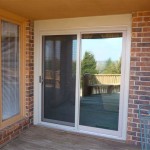How to Fix a Patio Slab
A patio slab is a beautiful addition to any home, providing a space for relaxation, entertaining, and outdoor dining. However, over time, these slabs can become cracked, uneven, or even sink. When this happens, it not only affects the aesthetics of your patio but also poses a safety hazard. Fortunately, fixing a patio slab is a manageable DIY project for homeowners with a little know-how and the right tools.
Assess the Damage
Before embarking on any repairs, it's crucial to accurately assess the extent of the damage. This will determine the best course of action for fixing the slab. Here's a step-by-step guide:
1.
Identify the type of damage:
Are the cracks hairline, spiderweb-like, or large and deep? Is the slab uneven, tilted, or sunken at a specific point?2.
Measure the cracks:
Use a measuring tape to determine the length and width of the cracks. This information will help in selecting the appropriate repair materials.3.
Check for underlying causes:
Sometimes, the root cause of a cracked slab is not the slab itself but a problem with the underlying soil or foundation. If the soil is unstable or the foundation is settling, the slab will continue to crack even after a repair.Repairing Cracks
Small, hairline cracks can be easily repaired with a sealant, while larger, deep cracks may require more extensive work.
Using a Sealant
1.
Clean the crack:
Thoroughly clean the crack using a wire brush, vacuum, or compressed air to remove any debris or dirt.2.
Apply sealant:
Choose a sealant specifically designed for concrete and patios. Apply it according to the manufacturer's instructions, typically using a caulking gun. Spread the sealant evenly into the crack, ensuring it fills the entire gap.3.
Smooth the sealant:
Use a putty knife or your finger (wearing a glove) to smooth out the sealant and create a seamless finish.4.
Allow to cure:
Give the sealant ample time to cure according to the manufacturer's instructions. This will ensure it bonds properly to the concrete.Using Epoxy
For larger, deeper cracks or those that are spiderweb-like, epoxy is a more robust solution.
1.
Prepare the crack:
Clean the crack as described above, ensuring the edges are clean and free from debris.2.
Mix epoxy:
Follow the manufacturer's instructions carefully for mixing the two-part epoxy resin and hardener. Work quickly, as epoxy sets rapidly.3.
Fill the crack:
Use a trowel or putty knife to fill the crack with the mixed epoxy.4.
Smooth and level:
Smooth out the epoxy with a trowel or putty knife, ensuring a seamless finish with the surrounding concrete.5.
Allow to cure:
Give the epoxy ample time to cure, typically 24 to 48 hours.Levelling Uneven Slabs
If your patio slab is uneven or sinking, you'll need to level it to restore its stability and prevent further damage.
1.
Determine the cause:
If the unevenness is due to settling soil, you'll need to address this prior to leveling the slab. This often involves compacting the soil beneath the slab.2.
Use leveling compound:
A leveling compound specifically designed for concrete can be used to fill low areas and create a level surface. This compound comes in a powder form that is mixed with water and applied with a trowel.3.
Apply the compound:
Pour the mixed leveling compound into the low areas of the slab, spreading it evenly with a trowel. Allow the compound to set according to the manufacturer's instructions.4.
Smooth the surface:
Once the compound has set, you can smooth out any rough edges or imperfections with a trowel or sandpaper.Tips for Success
To ensure your patio slab repair is successful, consider the following tips:
*
Use high-quality materials:
Invest in good-quality sealant, epoxy, or leveling compound, as this will ensure the repair lasts for years to come.*
Follow manufacturer instructions:
Pay close attention to the manufacturer's instructions for each product you use. This will ensure proper application and curing times.*
Work in stages:
If you have several cracks or uneven areas to repair, tackle them in stages to avoid overwhelming yourself and to allow for proper drying time between applications.*
Protect your existing slab:
Before starting any repairs, protect the surrounding area with drop cloths or plastic sheeting to prevent spills and damage.*
Consider professional help:
If the damage is extensive or you are not comfortable with DIY repairs, it's best to consult with a professional concrete contractor. They have the expertise and tools to ensure a successful repair.
How To Repair A Patio S Grouting Sinking Checkatrade

Fix Your Rocking Patio Slabs With This Easy Solution

Julian Cas S Diy Blog Archive Replacing A Broken Slab How To What Use Where Buy

How To Fix A Sinking Concrete Slab With Polyurethane Foam Jack Kings

How To Repair Paving Ideas Advice B Q

Patio Slab Pointing With Mortar 3 Diffe Methods

How To Fix Loose Paving Slabs

How To Fix Uneven Concrete Slabs 5 Options

The Best Way To Fix A Ed Patio

How To Repair Paving Ideas Advice B Q
Related Posts








